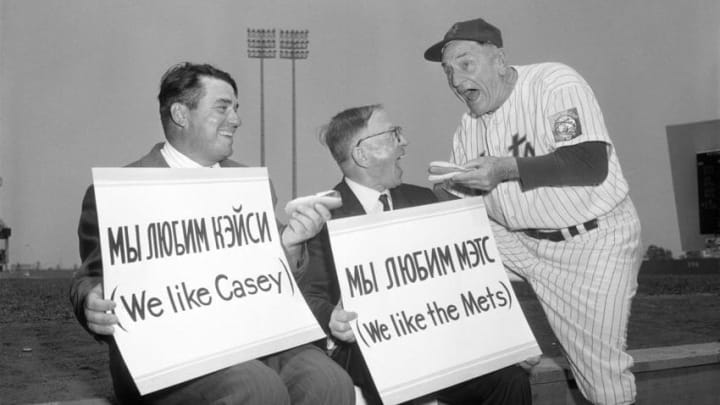It’s 1963 and the virtual New York Mets are hoping to improve from a last-place finish in 1962. Unfortunately, they didn’t.
In year two of simulating the history of the New York Mets, the club is still at the Polo Grounds and seemingly far away from any chance of contending. Only the top team in each league makes the playoffs. The climb there from the bottom will take a while.
The real-life 1963 Mets were almost as bad as the 1962 squad. With perimeters in place to keep MLB rosters the same as they were in 1963, I went into the year expecting a similar result.
Could these simulated Mets exceed expectations and climb closer to a championship sooner than expected?
Preseason
Unfortunately for the virtual Mets, they are predicted to go 42-120. This would match what they did in real life back in 1963. Amazingly, it’s a game worse than they were expected to do in our 1962 simulation.
Of course, the Amazins ended up winning 52 games.
No Mets players are expected to be one of the league’s top hitters or pitchers. Unlike last year when Frank Thomas found his spot on the preseason predictions list, this one is sans Metropolitan players.
In 30 spring training games, the Mets did little to prove the predictors wrong. At 11-19, they had the worst record in the National League. Only the American League’s Washington Senators at 10-20 were worse.
Regular Season Notes
Per the Mets general manager, the 1963 team has one expectation only: to stay respectable on the field. I have played OOTPB many times over the years in different leagues, different years, and with different settings. This is a first.
After beginning the season 2-1, the Mets came back to earth. It didn’t take long for the rest of the National League to leave them behind. Even the Houston Colt .45’s in their second year of existence managed to keep pace with everyone else.
The first half of the season ended with the Mets on pace to become the worst team of all-time. At 22-62, they are way at the bottom. Even the Colt .45’s have 14 more wins.
It’s no secret why the Mets are so bad. They are last or second-to-last in nearly every major statistic other than home runs. Thomas and Jim Hickman lead the team with 9.
However, neither of them will represent the Mets at the All-Star Game. Second baseman Ron Hunt finished second in the voting for National League second basemen, getting a reserve role behind Jim Gilliam of the Los Angeles Dodgers. He’ll be the first Mets All-Star in franchise history.
Hunt made the most of it, too. In one at-bat, he knocked a two-run double in the eighth inning. The NL still dropped the game, 9-5.
The second-half for the Mets begins with the team already 33.5 games out of first place. They were eliminated from postseason play in mid-August, doomed to play out the rest of the year with little purpose.
In the end, the 1963 season concluded with the team going just 43-119.
Honors
I’m going to skip this section for the 1963 season. It was bad. Real bad. Even Hunt failed to be among the league leaders in any statistic after a tremendous first half of the season.
Rather than dig deeper for any notable performances, let’s instead look at why this year was such a historic disaster.
Notable Individual Statistics
The Mets had five pitchers in the top eight of losses. Al Jackson lost 20, Roger Craig had 18, and three others had 17.
For the second straight year, all pitchers failed to reach double-digit wins. Once again, Jackson was the closest with 9 victories.
Unlike the previous year, there are some decent ERAs to discuss. Jackson’s 3.91 ERA was good but bettered by Carl Willey. The 5-17 record was bad but I do respect the 3.78 ERA Willey posted.
The bigger disappointment came from the bats. Hunt was by far the best hitter the club had with a .296/.350/.383 slash line. Hickman also managed to put together a solid year, slashing .270/.343/.451 with a team-leading 21 home runs.
There was plenty of bad, too. Five Mets with at least 100 plate appearances hit below the Mendoza Line. Shortstop Al Moran may have been the worst with a .173 average and 380 plate appearances.
Choo Choo Coleman, however, gives him a nice run for his money. In his 255 trips to the plate, he batted .165.
The biggest disappointment of all came from Thomas. The powerful slugger from 1962 hit .241 with 19 home runs. Clearly, he’s on the decline.
Want your voice heard? Join the Rising Apple team!
I knew coming into the 1963 season we would experience plenty of more rough patches. Little did I know this team was actually taking a big step backward. If there’s any consolation, at least they played all 162?
